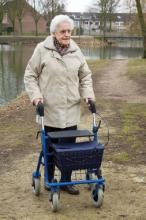PARIS – Women older than 65 years of age with early-stage breast cancer have worse long-term survival if they report poor overall health and have significant limitations in how far they can walk, according to the results of a prospective trial.
At 10 years, 80% of women with a low self-rated health status and a walking limitation had died, compared with 50% of those with a high self-rated health status and no walking limitation (P less than .0001). The probability of survival in women with low self-rated health but no walking limitation was 47%, and in those with high self-rated health and a walking limitation it was 44%.
"Approximately 192,000 new cases of invasive breast cancer were diagnosed in the United States in 2009," and more than half of those cases were in women older than age 60, said study investigator Dr. Jessica A. Eng of Boston University.
"There are many challenges in managing cancer in older adults," and one of the major ones is determining what the optimal treatment benefits are, compared with the risks, Dr. Eng added. Having a simple tool that could, early on, help identify those patients who are likely to do worse could be of great practical benefit, she suggested at the annual meeting of the International Society of Geriatric Oncology.
Dr. Eng and colleagues have previously shown that three or more deficits on a cancer-specific geriatric assessment are predictive of 5- and 10-year mortality in older women with breast cancer (Eur. J. Cancer 2011 July 7 [doi:10.1016/j.ejca.2011.06.016]).
In the current study, the researchers looked at whether self-rated health status and mobility could also be linked to mortality in the same population of 660 women who were aged 65 years or older and had stage I-IIIA breast cancer.
All women in the study were asked two questions at baseline: first, to rate their overall health as excellent, very good, good, or poor; and second, whether they could walk a couple of street blocks with no, a little, or a lot of limitation.
The women were followed for 10 years via annual telephone interviews, and the U.S. National Death Index was used to determine mortality rates.
At baseline, the majority of women were aged 65-79 years, with 18% aged 80 years or older. Most (94%) of the women were white, and 84% had 12 years or more of education. At least one comorbidity was present in 59% of participants, 51% had stage I breast cancer, and 76% were estrogen receptor positive.
Dr. Eng reported that 39% of women rated their health status as low, and 28% said that their ability to walk several street blocks was limited a little or a lot.
There was an absolute difference of 27% in the survival of women with a walking limitation plus high vs. low self-rated health, and a 24% absolute difference in the survival of women with low self-rated health plus no vs. some walking limitation.
Adjusted analysis showed that the risk of dying from any cause was doubled by being older than 80 years, with a hazard ratio of 2.11. The presence of at least one comorbidity also increased the risk of death significantly (HR, 1.37), compared with no comorbidity.
The hazard ratio for low self-rated health plus a walking limitation was 1.58. Separately, low self-rated health and a walking limitation did not increase the mortality risk.
"The combination of low self-rated health and limitation in walking several blocks at diagnosis is an important predictor of all-cause mortality at 10 years," concluded Dr. Eng, adding that the effect was independent of age, comorbidity, tumor characteristics, and treatment.
"Using these two easily assessed questions in clinical practice may represent an effective strategy to improve treatment decision making in older adults with cancer," Dr. Eng said.
The study was supported by the U.S. National Cancer Institute. Dr. Eng had no conflicts of interest.


